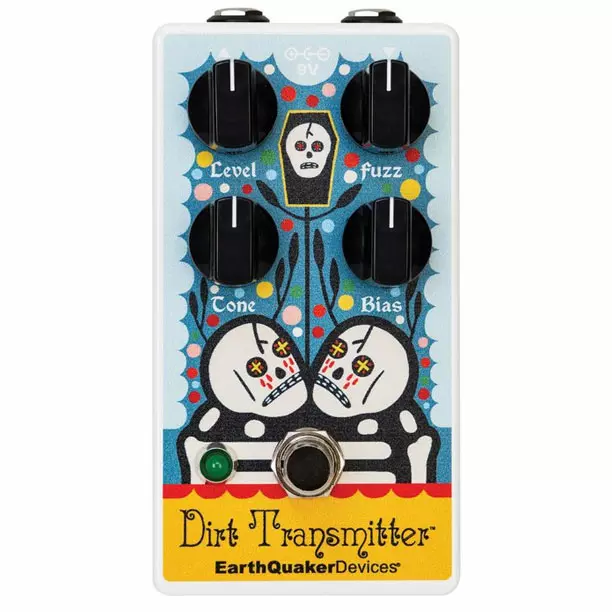
EarthQuaker Devices released a signature version of their 2008 Dirt Transmiter Fuzz, dedicated to legendary guitarist, producer Dave Catching, and EQD fan, with art designed by his friend Mike Egan. Catching invited the pedal company’s chief engineer Jamie Stillman to participate in a recording session at his studio Rancho de la Luna, during which legend has that the Dirt Transmitter was abused of.
We have to say it was worth the effort, beautiful art! You can find the full story here.
This is our review from 2008:
Fuzz pedals are a dime a dozen. What separates one fuzz from the next? There are different methods of achieving a “fuzz tone”, but which one sounds the best for my applications? There are boat loads of options and everyone claims to have “that tone”. So who do we trust? I found a good starting place in Earthquaker Devices. These guys know fuzz tone and they use quality components to get the job done right.
Today I am taking a look at the Dirt Transmitter. Due to the particular interaction between the Bias control and Tone knob, this one goes under the versatile category, although without these two controls this pedal would be just a really darn good fuzz pedal. I would still buy it just because it sounds great whether you have the Fuzz knob cranked for total destruction or have it backed off a bit for a gentle aural massage. The Fuzz knob simply controls the intensity of the Fuzz effect, whereas the Level knob controls the overall volume of the effected signal.
The fun really begins with this pedal when you start messing with the Bias and Tone controls. These controls work in conjunction to make for a huge variety of tonal options. The Bias knob basically controls the amount of current going to the transistors. The transistors are receiving optimal current when the knob is in its 2 o’clock position. If you turn it counter-clockwise from here the signal starts to fizzle out with far less sustain. When turned all the way counter-clockwise you’ve got yourself a “gated fuzz” WHICH has a velcro like audio character. The Tone knob essentially works as a Hi-Pass filter which keeps the tone from getting flabby in various stages of tweaking. Together, these tone shapers and dynamic controls can be manipulated with various levels of intensity using the Fuzz knob.
This may be the ultimate boutique fuzz pedal. It is extremely versatile and sounds good no matter how you have it set. This must be due to quality design and component selection. I have heard many fuzzes and this one is the first to win at versatility and overall tonal quality. I tested it with guitar, bass, synth and drum machine and it was equally fun with all of these sources. I liked that it was able to handle the low end of the bass without sounding wierd. I would actually recommend it as a bass fuzz too. On synth I ran a saw, triangle and square waves through it using my MIDI-enabled Korg Monotribe and used it as a waveshaper. I got some wicked tones using it in this way. I recommend leaving the filter wide open and running just the pure waves through it, and if you have one, run it through an oscilloscope and see how the controls effect the wave’s shape. In a sea of fuzz the Dirt Transmitter stands out! – Gus Green
This is how the original looks like:























